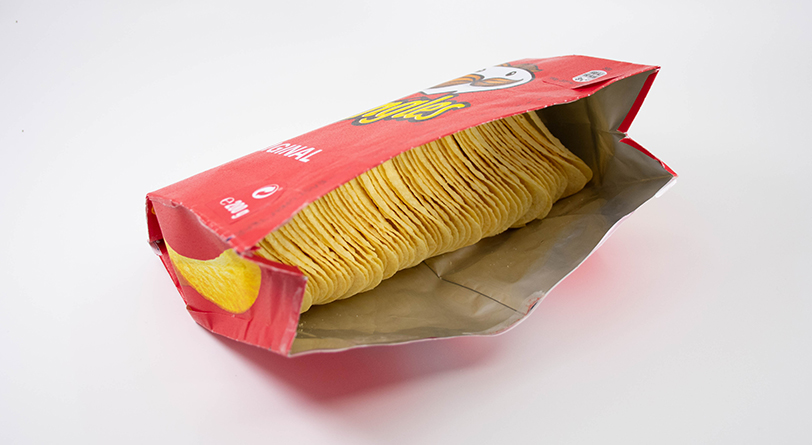Wouldn’t it be great to eat Pringles® chips without having to stick your hand down in the can? Essentially, that thinking was behind the flexible package that is the first-place winner of the 2024 Student Design Challenge held by the Flexible Packaging Association (FPA).
The students with the winning entry, Starr Gong and Logan Searles from the University of Wisconsin–Stout, solved the problem by creating a side gusset stand-up pouch with a reclose function that keeps the chips nicely stacked together—a standout feature associated with the way the chips lay on top of each other in the traditional paperboard canister.
The prototype opens into what is like a tray, where consumers turn the package on its side so they can hold the package horizontally, as opposed to vertically like the original can. They can then place the flexible package down on a table or hold it in their lap, according to the video that accompanied the winning entry.
“Our submission constitutes an improvement upon Pringles’ existing packaging rather than introducing an entirely new product,” the students say in their contest entry. “By replacing the current paper canister with the flexible side gusset stand-up pouch, we offer consumers a more convenient and user-friendly option. The design encourages customers to open the pouch from the side, eliminating the narrow opening issue associated with the previous packaging.”

The entry also won the Best Video Award in the contest, which included entries from packaging schools nationwide. The judges have been involved with FPA’s Emerging Leadership Council (ELC): Kasie Fairbarn, vice president of sales at Windmoeller & Hoelscher Corporation and ELC co-chair; Weston Harcourt, strategic account manager at Sonoco Flexible Packaging and ELC co-chair; and Jonathan Quinn, flexible packaging consultant and former ELC co-chair.
The judges went through each entry in May and rated them on a scale of 1 to 5 on various attributes, including innovation, operational feasibility, sustainability, and presentation. Their assessments were based on the students’ written descriptions of their entries, as well as videos about the prototypes, some of which offered details in slick videos that looked like a professional marketing team produced them.
The judges were particularly impressed with the video for the Pringles® entry, noting that it was visually appealing while demonstrating exactly how the package would work.
“It’s like a little purse,” Quinn says, noting the side closure of the package.
“I think it is innovative and it addresses the age-old problem of how to get the hand into the Pringles® can,” Fairbarn adds.
Quinn says the package is operationally feasible to mass produce, and the other judges note it does not require a lot of extra engineering.
“They clearly stated what the problem was in their video,” Fairbarn says about the student’s pitch. “They took a rigid package and made it into a flexible package. They turned it on its side—literally—and made it so you can get into it easily and you can seal it easily. And they did not try to over-engineer it with a bunch of fitments and add-ons. They kept it simple with operational feasibility.”
No More Messy Bacon Hands
They also liked the presentation and innovations behind an entry from California Polytechnic State University (Cal Poly) in San Luis Obispo, California, where students developed a prototype for a perforated precooked bacon package. The students dubbed the package “Sizzle Sleeves,” where individual servings of three precooked bacon strips are packaged in a sleeve and tray that can be microwaved. Five single-serve pouches are strung together by perforated connections, allowing for multiple single-serve uses. The serving tray allows the consumer to put the bacon in the microwave without having to touch the bacon. Ridges along the tray’s outer rim collect the grease of the precooked strips.
“We tried to envision the most convenient, least messy way to package bacon,” student designer Haaken Pedersen says after learning the Cal Poly team had won the award. “Though the quality of the bacon may be slightly lower, as it is precooked and needs to be microwaved, this packaging alternative allows for a more convenient and less messy—no pan needed or plate—way of cooking and eating bacon.”
The judges agree with the students that typical bacon packaging can be messy, with consumers having to open the whole package and then manually remove the strips by pulling them apart. Food waste becomes an issue for the traditional packaging because consumers rarely cook all of the bacon in the package at the same time. A container must be found for the uncooked bacon, which can spoil if not used within a few days, the judges say.
“They did a lot of work on the problem, with just the right serving amount,” Fairbarn says. “Its operational feasibility is strong.”
As a consumer, Quinn says, he finds the traditional bacon packaging difficult to use because the strips must be peeled apart from each other. As an expert in flexible packaging, he adds, people over the years have asked him to try to solve this very problem.
“I can’t tell you how many times I’ve had people reach out to me randomly and request that I go help bacon be packaged better,” he says. “They not only made it more convenient, but they also solved another challenging problem concerning food waste.”
Fairbarn says the student prototype also will have strong shelf appeal. “I feel like I would see it in a grocery store and be like, ‘Oh cool,’ ” she says.
Not Quite There
During the judging process, the judges say a lot of thought went into most of the entries, including those that did not win. Fairbarn points out that one entry attempted to address packaging that would help individuals with mobility issues such as people who are elderly.
“I find that truly fascinating,” Fairbarn says. “We’re already starting to see packaging that is designed for people where this is an issue. I think it is awesome that the students were giving that consideration.”
Other times, the judges mention that an idea is interesting but not operationally feasible because the packaging is over-engineered. That discussion comes up when it is not clear how a fitment would work or whether the fitment could be easily removed to enhance a package’s recyclability.
“When trying to bring something that is rigid into a flexible, that is what this competition is about, and it is what our companies are trying to do in this space,” Fairbarn says. At times, however, the instructions were not clear about how a complex package should work. “If you are going to add these things, please tell me, the consumer, or my children, how we can get them apart for recycling,” she says.
In another instance, the judges discussed disqualifying one prototype because flexible packaging portions were incorporated into a rigid plastic container, which diminished its sustainability properties.
With another entry, the judges noted it lacked details about what the prototype would accomplish. “This group tried,” Harcourt says about a package that did not win.
Those conversations led the judges back to the Pringles® prototype and the video that accompanied it.
“That is 100% the type of video that we are looking for—you could put it on social media. It’s professional and it’s entertaining,” Fairbarn says. “It’s a quick little commercial for the product but also has the right amount of design explanations and technical explanation.”
Overall, most of the students provided interesting, solid efforts, the judges say.
“There was a lot of innovation. There was a lot of thinking outside the box,” Fairbarn tells her colleagues. “It did not always work. It would not always be feasible, but I think those ideas will lead to better ideas.”
Quinn agrees, noting that further iterations of some ideas could lead to breakthroughs. “They are good first starts,” he says.
For the students, the experience has helped them better understand the flexible packaging industry and what it might offer for their careers.
“This success is a testament to our ability to address real-world packaging issues, improve upon existing solutions, and push the boundaries of what’s possible in packaging design,” Gong says after being notified of the first-place win. “Winning this competition is a powerful acknowledgment of students’ creativity and dedication. It demonstrates that the industry values fresh perspectives and innovative ideas from the next generation of packaging professionals.”
Searles, Gong’s co-winner, says the contest helped to apply knowledge being learned in college, offering a hands-on experience to understand different plastics and their properties.
“I have always had an interest in design, and this competition allowed me to exercise that interest,” Searles says. “From this, I see the endless applications for flexible packaging and my potential in the industry.”
Thomas A. Barstow is senior editor of FlexPack VOICE®.
Sidebar: Content Awards
- First place, with a $1,000 prize awarded to the winner. (This entry also won the Best Video Award): Starr Gong and Logan Searles, University of Wisconsin–Stout
- Second place, with a $500 prize shared among the winners: Garrett Foster, Haaken Pedersen, and Clorinda Webb, California Polytechnic State University
NOTE: The winning entries will be on display during PACK EXPO International, November 3–6, 2024, in Chicago.
